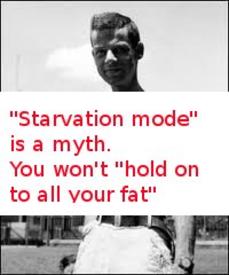We are pleased to announce that on March 4, 2025, an updated Rich Text Editor will be introduced in the MyFitnessPal Community. To learn more about the upcoming changes, please click here. We look forward to sharing this new feature with you!
Healthy Weight Loss Rate

Dannilee2013
Posts: 37 Member
Hi
I know when you have a lot to lose you can aim for 2lb a week, but is that still a safe rate when you have just over a stone to lose?
Thanks
D
I know when you have a lot to lose you can aim for 2lb a week, but is that still a safe rate when you have just over a stone to lose?
Thanks
D
0
Replies
-
Well, being safe and being a good idea are two different things. You could try setting your goals at 2 pounds per week, and if it doesn't make you go bonkers, go for it. But realistically, you'll probably be happier with a less ambitious setting.0
-
Things you have to consider:
- The lighter you are the less room you have to create a calorie deficit without dropping to unhealthy calorie levels
- You can try to make up the difference with exercise, but it will be hard. Leaving you hungry, possibly moody and more likely to binge.
I personally prefer a slower approach, because too much of a deficit makes me one h#$% of a b*&^% and I am definitely more likely to binge and undo all the work I did.0 -
No. With about 14 pounds to lose you're in the 1/2 pound per week realistic goal ... unless you want to lose lean mass.0
-
No. The less you have to lose, the greater the chance for muscle loss if you choose too high a deficit. Plus, as MFP will not give you an intake below 1200 calories, you most likely wouldn't be hitting 2 pounds a week anyway. .5-1 pound per week will be a better choice for you.0
-
Thanks
I actually have been hitting the 2lb a week loss for the last 2 weeks, after hitting a plateau which latested over 6 months. For the last 2 week I have been eating 1750 calories a day and walking 5-6 miles a day and have lost almost 5lb. I feel fine, no hunger, moodiness etc. But I don't want to lose muscle mass.
Should I be trying to net 1200 each day?0 -
Yes0
-
This content has been removed.
-
A more important question to ask is how much do you weigh, not how much do you have to lose. With the exception of people who are obsessed with reaching a dangerously low body fat percentage, 1% of your weight is a good goal. For those of us with a goal weight of over 200lbs, that will always be 2lbs. For someone aiming for 100lbs, that will be 1lb. Most people will fall in between.0
-
TimothyFish wrote: »A more important question to ask is how much do you weigh, not how much do you have to lose. With the exception of people who are obsessed with reaching a dangerously low body fat percentage, 1% of your weight is a good goal. For those of us with a goal weight of over 200lbs, that will always be 2lbs. For someone aiming for 100lbs, that will be 1lb. Most people will fall in between.
Thanks, I currently weight 11st 2lb, so going off what you are saying I should be aiming for 1.2lb a week loss.
That would be around a 750 deficit a day?
Many places/people say you can come to that deficit by cutting back on your calories alone, by exercise alone or a combination of both. Others say it is best to get the deficit from calories reduction. I have lost over 6 stone and whilst a combination did work well. Now I am closer to my goal it's not working.
I mean I have tried to create the deficit from exercise alone. I wore a HRM whilst exercising, making sure I burned at least 500 calories a day, whilst eating my TDEE and instead of losing I actually gained 1lb. I tried that 3 weeks in a row and gained each week. I then tried cutting the 500 calories from my food alone and lost.
Suppose it's different or everyone.0 -
-
Dannilee2013 wrote: »TimothyFish wrote: »A more important question to ask is how much do you weigh, not how much do you have to lose. With the exception of people who are obsessed with reaching a dangerously low body fat percentage, 1% of your weight is a good goal. For those of us with a goal weight of over 200lbs, that will always be 2lbs. For someone aiming for 100lbs, that will be 1lb. Most people will fall in between.
Thanks, I currently weight 11st 2lb, so going off what you are saying I should be aiming for 1.2lb a week loss.
That would be around a 750 deficit a day?
Many places/people say you can come to that deficit by cutting back on your calories alone, by exercise alone or a combination of both. Others say it is best to get the deficit from calories reduction. I have lost over 6 stone and whilst a combination did work well. Now I am closer to my goal it's not working.
I mean I have tried to create the deficit from exercise alone. I wore a HRM whilst exercising, making sure I burned at least 500 calories a day, whilst eating my TDEE and instead of losing I actually gained 1lb. I tried that 3 weeks in a row and gained each week. I then tried cutting the 500 calories from my food alone and lost.
Suppose it's different or everyone.
HRMs are not calorie counters. They vastly overestimate when not used for the limited number of activities they are designed to come close for.
A deficit, no matter how it is created, is what leads to weight loss.0 -
Does anyone have an actual study for this, as opposed to the brackets that get posted constantly here?brianpperkins wrote: »No. With about 14 pounds to lose you're in the 1/2 pound per week realistic goal ... unless you want to lose lean mass.
If your deficit is still within the amount of calories that can be converted from body fat, why would you be at a greater risk of loss of lean mass by losing more than half a pound a week?
0 -
Those brackets are planning factors, not best case numbers.
Studies put the theoretical maximum at 31 calories per day per pound of fat. At 14 pounds to lose ... assuming reaching that theoretical maximum and that all 14 pounds to lose are fat ... that comes out to about .8 pounds per week. At ten pounds to lose, it drops to .6 pounds per week with the same planning assumptions.
0 -
Well I can only speak from personal experience, and for me whenever I have eaten my TDEE and burned the 500+ calories solely from exercise I have never lost and have often gained. I know my calorie burn is accurate because I wear a Miolink HRM connected to a Garmin Edge 1000 and I upload as a walk to Strava.
I know many will disagree because in theory it shouldn't be possible. But it's what I have always found. The moment I create my deficit from my food intake the weight starts to come off again.
0 -
Dannilee2013 wrote: »Well I can only speak from personal experience, and for me whenever I have eaten my TDEE and burned the 500+ calories solely from exercise I have never lost and have often gained. I know my calorie burn is accurate because I wear a Miolink HRM connected to a Garmin Edge 1000 and I upload as a walk to Strava.
I know many will disagree because in theory it shouldn't be possible. But it's what I have always found. The moment I create my deficit from my food intake the weight starts to come off again.
HRMs are not calorie counters. Garmin Edges are designed to track cycling, not walking.
0 -
HRMs do determine the calorie consumption of aerobic exercise with elevated heart rate, at least the ones with enough input data do.
as the rate at which fat reserves can supply calories.Studies put the theoretical maximum at 31 calories per day per pound of fat.
So starting at 11st2 or 156 lbs and aiming to get to say 120 lbs there's 36 lbs to lose and initially 56 lbs of fat = 1700 cals/day worth and eventually 20 lbs = 600 cals/day worth, assuming 100 lbs FFM throughout.
Using this approach everyone should be able to lose 1 lb/week ?0 -
I lost 51 pounds since January 1st with 9 lbs. to go to hit a BMI under 25. I set my calories at a 1 lb. weight loss a week and currently log my cardio which is cycling. All other activities weights/core exercises/yard work I leave out. I do agree the down side is the loss of muscle mass which will take months to recover....0
-
ThanksHRMs do determine the calorie consumption of aerobic exercise with elevated heart rate, at least the ones with enough input data do.
as the rate at which fat reserves can supply calories.Studies put the theoretical maximum at 31 calories per day per pound of fat.
So starting at 11st2 or 156 lbs and aiming to get to say 120 lbs there's 36 lbs to lose and initially 56 lbs of fat = 1700 cals/day worth and eventually 20 lbs = 600 cals/day worth, assuming 100 lbs FFM throughout.
Using this approach everyone should be able to lose 1 lb/week ?
Thanks, I only want to get to 10st, that is my goal. I understand why some may want to go much lower but I am actually in a size 8-10 at my current weight and when people ask my weight they don't believe me. I've actually heard people saying she is too skinny, or she has taken it too far she's tiny (SO annoying). But I do know that I look a lot smaller than the scales indicate. Even my doctor asked me why I was trying to lose weight, he was surprised by the scales lol
After having two kids I carry most of my excess weight on my stomach (which is easily hidden lol) but in terms of how I look I am actually happy as I am, it's just for medical purposes I want to lose the extra stone.
0 -
HRMs do determine the calorie consumption of aerobic exercise with elevated heart rate, at least the ones with enough input data do.
as the rate at which fat reserves can supply calories.Studies put the theoretical maximum at 31 calories per day per pound of fat.
So starting at 11st2 or 156 lbs and aiming to get to say 120 lbs there's 36 lbs to lose and initially 56 lbs of fat = 1700 cals/day worth and eventually 20 lbs = 600 cals/day worth, assuming 100 lbs FFM throughout.
Using this approach everyone should be able to lose 1 lb/week ?
Everyone? No. Theoretical maximums does not mean real world potential. I've yet to meet a person living under laboratory conditions.
0 -
brianpperkins wrote: »Those brackets are planning factors, not best case numbers.
Studies put the theoretical maximum at 31 calories per day per pound of fat. At 14 pounds to lose ... assuming reaching that theoretical maximum and that all 14 pounds to lose are fat ... that comes out to about .8 pounds per week. At ten pounds to lose, it drops to .6 pounds per week with the same planning assumptions.
The problem with that is that it assumes that the person only has 14 pounds of fat. At a healthy 20% body fat, even a 100 pound person would have 20lbs of fat. By your figures, that would be 620 calories per day, which is more than 1lb per week.0 -
At 225, even at 15% BF, I'd have over 1,000 calories a day available from body fat alone. Even if I'm operating at only 50% of what can be pulled from fat, that's still over a pound a week worth of deficit that can be covered by fat stores.brianpperkins wrote: »HRMs do determine the calorie consumption of aerobic exercise with elevated heart rate, at least the ones with enough input data do.
as the rate at which fat reserves can supply calories.Studies put the theoretical maximum at 31 calories per day per pound of fat.
So starting at 11st2 or 156 lbs and aiming to get to say 120 lbs there's 36 lbs to lose and initially 56 lbs of fat = 1700 cals/day worth and eventually 20 lbs = 600 cals/day worth, assuming 100 lbs FFM throughout.
Using this approach everyone should be able to lose 1 lb/week ?
Everyone? No. Theoretical maximums does not mean real world potential. I've yet to meet a person living under laboratory conditions.
Those brackets are about as terrible as BMI the farther you get from the middle of the bell curve in either direction.
0 -
DeguelloTex wrote: »
At 225, even at 15% BF, I'd have over 1,000 calories a day available from body fat alone. Even if I'm operating at only 50% of what can be pulled from fat, that's still over a pound a week worth of deficit that can be covered by fat stores.brianpperkins wrote: »HRMs do determine the calorie consumption of aerobic exercise with elevated heart rate, at least the ones with enough input data do.
as the rate at which fat reserves can supply calories.Studies put the theoretical maximum at 31 calories per day per pound of fat.
So starting at 11st2 or 156 lbs and aiming to get to say 120 lbs there's 36 lbs to lose and initially 56 lbs of fat = 1700 cals/day worth and eventually 20 lbs = 600 cals/day worth, assuming 100 lbs FFM throughout.
Using this approach everyone should be able to lose 1 lb/week ?
Everyone? No. Theoretical maximums does not mean real world potential. I've yet to meet a person living under laboratory conditions.
Those brackets are about as terrible as BMI the farther you get from the middle of the bell curve in either direction.
So now your stats apply to everyone? Nice to know.
Your assertion that you would have 1000 calories per day assumes that everything is under ideal theoretical conditions. Now back to your intermingling of theoretical maximums and planning factors.
0 -
brianpperkins wrote: »Everyone? No. Theoretical maximums does not mean real world potential. I've yet to meet a person living under laboratory conditions.
http://www.ncbi.nlm.nih.gov/pubmed/15615615A limit on the maximum energy transfer rate from the human fat store in hypophagia is deduced from experimental data of underfed subjects maintaining moderate activity levels and is found to have a value of (290+/-25) kJ/kgd. A dietary restriction which exceeds the limited capability of the fat store to compensate for the energy deficiency results in an immediate decrease in the fat free mass (FFM). In cases of a less severe dietary deficiency, the FFM will not be depleted.
I don't have the original full text, but I don't see "laboratory conditions" as being anything relevant. The author did a curve fit on loss rates experienced by people and drew a conclusion about a rate limit from what he saw. Not "theoretical".
We know an obese man can lose 0.7 lbs/day on average over a long period from other published data. At 0.2 grams/min that's well within observed fat oxidation rates.
0
This discussion has been closed.
Categories
- All Categories
- 1.4M Health, Wellness and Goals
- 391.4K Introduce Yourself
- 44K Getting Started
- 259.7K Health and Weight Loss
- 175.6K Food and Nutrition
- 47.5K Recipes
- 232.3K Fitness and Exercise
- 388 Sleep, Mindfulness and Overall Wellness
- 6.4K Goal: Maintaining Weight
- 8.5K Goal: Gaining Weight and Body Building
- 152.7K Motivation and Support
- 8.1K Challenges
- 1.3K Debate Club
- 96.4K Chit-Chat
- 2.5K Fun and Games
- 4K MyFitnessPal Information
- 22 News and Announcements
- 918 Feature Suggestions and Ideas
- 2.7K MyFitnessPal Tech Support Questions









